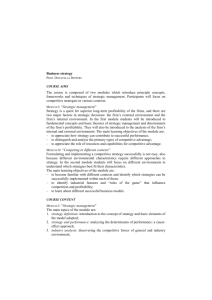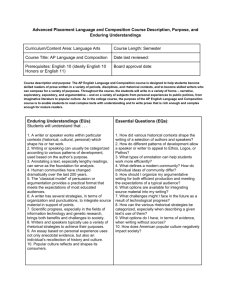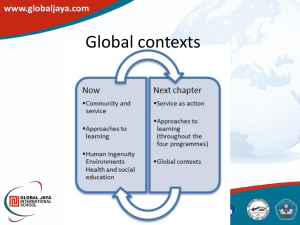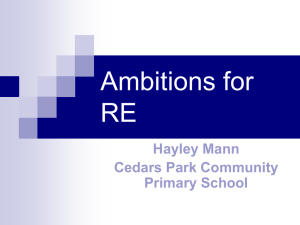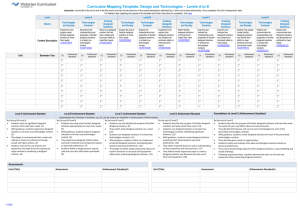Explaining `new contexts` - Department for Education and Child
advertisement
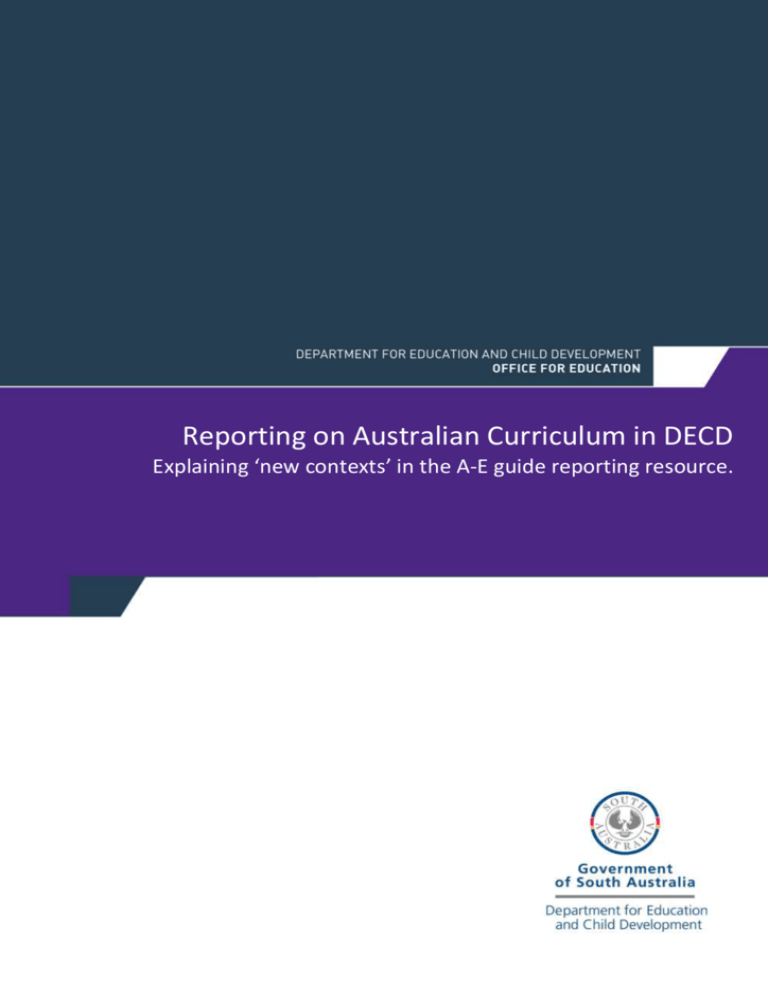
Reporting on Australian Curriculum in DECD Explaining ‘new contexts’ in the A-E guide reporting resource. Teaching and planning for “new contexts” This document is designed to support teachers to use the A – E guide reporting resource (page 12) effectively, and in particular to plan for, enable, recognise and assess learning in new contexts. The demonstration of learning in new contexts requires transfer of learning. Transfer of learning is the ability to apply relevant knowledge, skills, understandings, dispositions and learning strategies to new learning situations, modes or contexts. Taking new contexts into account when assigning a grade requires teachers to purposefully think about and plan for the demonstration of learning in a range of contexts throughout their teaching and across students’ learning experiences. The Learning Design model of the teaching, learning and assessing cycle facilitates consideration by the teacher of what students bring and what is important about the intended learning. One of the intentions of the A – E guide is to support teachers in the development of engaging and challenging curriculum, pedagogy and assessment which embeds intellectual stretch for all students and develops them as powerful learners. The expectation that students demonstrate capacity to apply knowledge, skills and understandings in new contexts to achieve at least a ‘C’ (satisfactory) level of achievement reflects this intention. Transferable learning To explicitly assess transfer of learning, teachers need to plan for teaching and learning to occur such that students are able to demonstrate their learning in new contexts. In order for learning to enable “All young Australians to become successful learners, confident and creative individuals and active and informed citizens” (Melbourne Declaration, 2008, p.8) the Australian Curriculum provides “… the base for (their) future learning, growth and active participation in the Australian community.” (Australian Curriculum and Reporting Authority, 2014) For this to happen, schooling needs to develop transferable learning that sets young Australians up for lifelong learning as participants in further education, paid employment and the community. Transferrable learning is seen in many educational settings as “… the core purpose of education, with transfer, or application of learning inferring that some jump between contexts has been made, wherein what is learned in one setting is applied to another situation” (Williamson and Schell, n.d). There is a considerable body of evidence which affirms that the understanding and demonstration of learning is most obvious when that learning can be transferred to new situations and applied in contexts other than that in which it was learnt (Darling-Hammond and Austin, 2003). It is the transfer of learning that enables learning to be consolidated into a range of contexts and enables the student to make links and connections to new learning. Therefore, in assessing learning, opportunities need to be provided for students to demonstrate their learning in different contexts. McTighe refers to transfer of learning as “… the ability to take what is learned in one situation and … apply it to other, related but different situations” (Wiggins and McTighe, 2005, n.p.). McTighe further describes transfer of learning as “… about independent performance in context. You can only be said to have fully understood if you can apply your learning … Transfer is about intelligently and effectively drawing from your repertoire, independently, to handle new contexts” (McTighe, 2014, p.1). Page 2 of 12 Dylan Wiliam relates the application of learning in new contexts to his formative assessment strategy of success criteria and making learning intentions clear. Shirley Clarke notes (Wiliam, 2011) that to teach students something and ask them to only reiterate that learning in assessment is a shallow approach to teaching and learning. Wiliam builds on this point, identifying that as teachers we must be interested in students’ ability to “… apply their newly acquired knowledge to a similar but different context” (Wiliam, 2011, p.60). “It is especially important to understand the kinds of learning experiences that lead to transfer …” (Bransford et al, 2000, p. 51). The notion of transfer has implications for teachers as they plan for teaching, learning and assessment. In thinking about the application and transfer of learning, teachers must consider, “What is it about what I am teaching now that will be of value, of use, and a source of understanding for my students at some point in the future, when they are in a situation that is not identical to the one they’re in now?” This requires teachers to think about the bigger picture of learning, as well as, “Where are my students in the curriculum now?”, and “Where might this learning be going?” Such thinking is fundamental to teaching for transfer (Darling-Hammond and Austin, 2003). Students take their deepened knowledge or fluent skill and apply it in a different way or context to generate new understandings and insights. In doing so, students have travelled from being consumers of knowledge to users of knowledge. This allows students to use newly learned information and procedures to connect to the real world so that they not only know but can utilize them. (Edwards, Marzano Centre, 2014) In summary, transferable learning is a valued and expected outcome of education and is measured by the degree to which learning can be demonstrated in new contexts. In South Australia, the ability to use the learning described in the curriculum in a new context is the criteria for satisfactory achievement. Teachers need to purposefully plan for, make explicit and assess for new contexts. What needs to be new about a new context? ‘New contexts’ is intended to mean that the student is able to apply the learning described in the achievement standard to a context beyond that in which it is originally taught. Identifying what is and is not a new context may not be straightforward. What seems obvious in one learning area may not have a clear correlation to another learning area. The distinction between reproducing knowledge and skills as learnt and using learning to produce something new is not always clear cut. In part, this may be due to differing perspectives on context. Similar issues have occurred for researchers working with transfer of learning and in an attempt to clarify this, Barnett and Ceci, (2002) identified 6 dimensions in which contexts may vary from near transfer of learning (close to original learning) to far transfer of learning (distant from original learning). Page 3 of 12 They are: Dimension Learning Area Near transfer Same example e.g. wood sanding learnt with bowl & continued applying to bowl Time Same lesson e.g. use what you have learnt this lesson about how to find the slope of a line Place Same room e.g. learnt in the classroom & used in the classroom Far transfer Interdisciplinary Same topic/ new example Same learning area/new topic e.g. map scales learnt with school ground map & applied to showground map e.g. science learnt in chemistry & used in biology Same week/ new day Same term/ new week Same year & beyond e.g. what do you remember from yesterday about how to start a narrative? e.g. what do you remember about safety from last time we used a bunsen burner? e.g. What do you already know about ancient Greece? Outside Away from school Another classroom e.g. learnt in the classroom used in the library Authority Same authority e.g. formal learning at school, formal learning outside school, non-academic e.g. learnt in school, used in school Social Same e.g. Individual or group e.g. learnt individually & used individually Mode Same mode e.g. oral/aural text, diagram, demonstration hands on, ICT, face to face, artwork (music, media, dance, drama, visual) e.g. learnt from text and a diagram & used to produce text and a diagram e.g. learnt in the classroom & used on the oval e.g. fractions learnt in maths & used in music e.g. learnt at school, used at the beach Different authority e.g. learnt at school, used in play Different e.g. learnt individually, used in a group Different mode e.g. learnt from text and a diagram & used to produce a drama Not all of these dimensions are equally useful in devising tasks in new contexts. For example, evidence of transfer to a non-academic setting outside of school could need to be identified by the learner. In addition, transfer can also differ in how the learning was cued. Learning which is prompted e.g. do a multiplication is not showing the same degree of transfer as learning which has been chosen by the learner e.g. in planning an excursion the learner asks how much will it cost for all of us to go to a movie? So what does this mean for us as educators striving to help students develop transferable learning and looking for evidence of satisfactory achievement? What it doesn’t mean is that the new context needs to tick all of the boxes on the far transfer side. Some learning areas will be better suited to particular kinds of new context than others. For example, learning about what makes events significant in Australian history could transfer to a new topic of significant events in the history of an ancient civilisation but it is harder to find a new topic for explaining day and night on earth. This might be better done with changing the representation so that if it was learnt using diagrams and videos, it could be used to produce a drama or animation. What it does mean however, is that over the course of the teaching and learning period, teachers need to look away from the near transfer examples and incorporate some of the far transfer Page 4 of 12 examples into the tasks set for learners and especially those which they plan to use as evidence for the purpose of assigning and reporting a level of achievement. Examples of possible ‘new contexts’ Arts: Visual Art Year 5 and 6 From the achievement standard: Students use visual conventions and visual arts practices to express a personal view in their artworks. Teaching: Explore ideas and practices used by artists to represent different views, beliefs and opinions. Develop and apply techniques and processes when making their artworks. New Context: Same topic/different mode - Students show their learning by making an artwork. For example: Using visual arts conventions (lines, colour, shape) and practices (paint) explored in Edvard Munch’s ‘The Scream’, students make their own artwork, sharing their views, beliefs and opinions relating to bridges. Arts: Drama Year 9 and 10 From the achievement standard: Students analyse the elements of drama, forms and performance styles and evaluate meaning and aesthetic effect in drama they view. Teaching: Evaluate how the elements of drama, forms and performance styles in devised and scripted drama convey meaning and aesthetic effect through Victorian melodrama. New context: Same topic/new example - Students show their learning within contemporary drama. For example: Students present their written analysis of 3-5 elements of melodrama in their choice of dramatic texts (television, graphic novel, film, computer game). English Year 4 From the achievement standard: Students create structured texts to explain ideas for different audiences. Teaching: Review and discuss two or more fairytales. Discuss how the fairytales are similar or different. Draw comparisons between fairy tales and examine what makes a fairytale. New context: Same topic/different mode - Students show their understanding of this structured text by producing their own text. For example: Create a new version of a fairytale for a young audience, explain the features that make it suitable for the younger audience and present it orally to a younger audience. Year 9 From the achievement standard: Students select evidence from the text to analyse and explain how conventions are used to influence an audience. Teaching: Examine and discuss metaphors using poetry from a particular poet and poem (e.g. a Wilfred Owen war poem). New context: Same topic/new example – Students show their learning with another poem by the same author. For example: Select a poem from the same author, find the conventions and explain their use. This would be a satisfactory level of achievement. To select a different poet and poem (e.g. war poem) Page 5 of 12 and explain the language choices and conventions (e.g. metaphors) will provide new context evidence at above satisfactory (A or B). Geography Year 3 From the achievement standard: Students describe the characteristics of different places at the local scale and identify and describe similarities and differences between the characteristics of these places. Develop geographical questions to investigate. Teaching: Students identify and describe types of settlements (e.g. towns, cities, regional centres) in Australia. They look at the lives of people (work, leisure, homes) and the demography (age, religion, language) of these places. They describe the similarities and differences. New context: Same topic/new example and different mode – Students apply this understanding of the characteristics of different places when identifying and describing similarities and differences between living in a chosen settlement of Australia and a neighbouring country. For example: Students play the role of a child from a neighbouring country describing the characteristics of that country. The audience prepares questions to ask of the presenter that provide opportunities for comparison with Australia. Year 9 From the achievement standard: Students analyse interconnections between people, places and environments and explain how these interconnections influence people, and change places and environments. Teaching: Using a range of data students study a city and in a report describe the characteristics of the city that have developed over time as a result of the interconnections that operate between the environment and the people who inhabit and function within the city. New context: Same topic/ different example and different mode – Students are able to apply this analysis to another regional town, suburb or geographical place. For example: Students analyse data about a different place (e.g. river delta, country service centre, industrial area) and explain the characteristics that have evolved as a result of interconnections. With a specific audience in mind, students communicate their findings and recommendations for preferred futures using digital technology. Health and Physical Education Year 5 and 6 From the achievement standard: Students access and interpret health information and apply decision making and problem solving skills to enhance their own and others’ health, safety and wellbeing. Teaching: Students investigate community resources and strategies where they and others can seek help, information and management strategies about their health, safety and wellbeing. This may include visiting community health and safety service providers. New context: New authority - Students communicate their learning about local community health and safety resources to their school community. For example: Students communicate the information they have gathered about how their local health and safety services assist children and families to make healthy decisions, to other students in their school. They design a clear social media message which they communicate through a social media network, whole school event or publication. Page 6 of 12 Year 9 and 10 From the achievement standard: Students apply and transfer movement concepts and strategies to new and challenging movement situations. Teaching: Develop, implement and evaluate movement concepts and strategies in stick sports (e.g. lacrosse) for successful outcomes. New context: Same skill/new example - Transfer specialised movement concepts and strategies from one stick sport (lacrosse) to another (e.g. hockey) to solve movement challenges. Use decision making and problem solving in a modified game which is unfamiliar to the participants. For example: Using hockey sticks, 3 attackers need to maintain possession of the ball (against a defender) in a restricted space (20m x 20m) over a set period of time (90 seconds). Students describe the strategies and movements required, provide the instructions to put them in place, then trial and evaluate them. History Year 2 From the achievement standard: Students sequence events in order, using a range of terms related to time. Teaching: Investigate the history of a building, landmark, streetscape or landscape in the local community using sources (photographs). Sequence the photos from earlier to later, giving reasons for the sequencing. New context: Same subject/new topic – Create a timeline to demonstrate changing technology in people’s lives using a set of annotated images of technology changes over time (e.g. road transport, kitchen appliances, telephones, toys). For example: Students order and explain the sequence of images in terms of changing technology and discuss the way this has shaped people’s lives. Year 8 From the achievement standard: Students identify the motives and actions of people at the time. Explain the significance of an individual and how they influenced the beliefs and values of their society. Teaching: Depth study of the Vikings (c.790 – c.1066). New context: Same topic/different mode – Show an understanding of Viking society and expansion, including the role of a significant individual, using a different mode to present their identification and explanation. For example: Use a concept cartoon1 to identify and explain the actions and motives of Vikings in their expansion out of Scandinavia. The depth and sophistication of their explanation will determine the quality of achievement against the standard. 1 www.conceptcartoons.com Page 7 of 12 Mathematics Year 1 From the achievement standard: Students describe number sequences resulting from skip counting by 2s, 5s and 10s. Teaching: Teach skip counting by 2s, 5s and 10s, starting at zero, using buttons, shells and blocks. New context: Same topic/new example - Demonstrate skip counting by 2s, 5s and 10s with counters or another different material. Notice and describe the resultant number sequences to 100. For example: Explore and consider alternative counting strategies. When considering skip counting, students describe number sequences that result from skip counting by 2s, 5s and 10s and identify the cardinal number for the collection. Year 8 From the achievement standard: Students solve problems relating to the volume of prisms. Teaching: Students construct the formulae for volumes of rectangular and triangular prisms and then use the formulae to solve problems involving volume. New context: Same topic/new examples - Find the volume of new prisms (not seen before in teaching examples). Calculate the dimensions of a prism from a given volume and produce a model. Solve problems related to volume. For example: Generate 3 random numbers to be the sides of a prism and calculate its volume. Students could then be asked to produce a 3D model of both a rectangular and a triangular prism with a volume of 9000cm3. This could be a container for e.g. biscuits; shoes; a game, and linked to the next component of the task. Given relevant specifications, students calculate the number of containers e.g. biscuit boxes that will fit into a certain 3D space e.g. a larger carton, and then the number of cartons that will fit into a container for transport on a container ship. An added dimension could be to have students argue whether the most efficient shape is a rectangular or a triangular prism. Science Year 5 From the achievement standard: Students classify substances according to their observable properties and behaviours. Teaching: Solids, liquids and gases have different observable properties and behave in different ways. Investigate changes of state from ice to liquid water and then water vapour. New context: Same topic/new example – Identify observable properties during change of state of different substances. For example: Observing a burning candle, students record their observations of solids and liquids, and explain how they distinguish between them. Students then observe a substance such as methylated spirits/perfume/nail polish remover* evaporating, record their observations of liquids and gasses and explain how they distinguish between them. *Remember to complete a risk assessment form before using chemicals in your classroom and consult the MSDS (Material Safety Data Sheet) on the product. Page 8 of 12 Year 10 From the achievement standard: Students evaluate the evidence for scientific theories that explain the origin of the universe and the diversity of life on Earth. Teaching: The universe contains features including galaxies, stars and solar systems. The Big Bang theory can be used to explain the origin of the universe and is taught with a DVD resource followed by class discussion. New context: Same topic/different mode - Use a different mode to discuss the evidence of the Big Bang theory. For example: What evidence is there of the Big Bang scientific theory in the words from the theme of the TV show “Big Bang”? What other valid evidence can you find that supports the theory? Technologies: Digital Technologies Year 3 and 4 From the achievement standard: Students define simple problems, design and implement digital solutions using algorithms that involve decision-making and user input. Teaching: Use pictures and text to describe the sequence of steps needed to navigate through a game. New context: Same topic/New mode - Students demonstrate their learning by creating a new game with sequences and decisions. For example: Students create a ‘choose your own adventure’ game using a narrative that they have worked on as a literacy task and tools such as PowerPoint and hyperlinked objects to create the interactivity. Technologies: Design and Technologies Year 7 and 8 From the achievement standard: Students explain how the features of technologies impact on designed solutions and influence design decisions for each of the prescribed technologies contexts. Teaching: Within the context of Materials and technologies, students research a range of materials (e.g. plastic straws, pop sticks, pipe cleaners, balsa wood, wire) to create a solution using engineering principles. Students compare the effectiveness and features of the materials (e.g. tactile strength of the material, design concept) to build a tower that will take a prescribed weight. They develop criteria for measuring and comparing the effectiveness of the various materials and designs. As a class, place the most and least successful towers into the simulator to gain understanding of how manufacturers use this technology. New Context: Same topic/New authority - Students use information about materials and design from the tower exercise to determine the optimal engineered solution for a different construction (i.e. a bridge, where the design relates to length rather than height as in the tower) to design, test in a simulator and build. For example: Students select materials, design, and test a model bridge that will span a river. They research the strength coefficients of a range of materials and use this data to test their assumptions about the ability of the chosen material to support the length of a bridge. Based on the best result they proceed to build the bridge from that material and explain their choices. Page 9 of 12 References Australia. Ministerial Council on Education, Employment, Training and Youth Affairs (Curriculum Corporation). (2008) The Declaration on Educational Goals for Young Australians Melbourne [Online] Available at http://www.google.com/url?url=http://www.curriculum.edu.au/verve/_resources/National_Declar ation_on_the_Educational_Goals_for_Young_Australians.pdf&rct=j&frm=1&q=&esrc=s&sa=U&ei=a hbzU9i5Ctfe8AXB_oHQBg&ved=0CBQQFjAA&usg=AFQjCNGsZrp6R8x_QNVWdVmnniKX3zHaEQ [Accessed: 20 August 2014] Australian Curriculum, Assessment and Reporting Authority (ACARA) (n.d.) Australian Curriculum [Online] Available at http://www.australiancurriculum.edu.au/ [Accessed: 20 August 2014] Barnett, S. M. & Ceci, S. J. (2002). When and where do we apply what we learn? Psychological Bulletin, 128, 612–637. [Online] Available at http://scholar.google.com/scholar_url?hl=en&q=http://rapunselshair.pbworks.com/f/barnett_2002 .pdf&sa=X&scisig=AAGBfm01wcIDSEuWOVT_ywI1Z9UGhCz19Q&oi=scholarr [Accessed: 22 August 2014] Bransford, J.D., Brown, A.L. and Cocking, R.R. (Eds.) (2000) How people learn. Commission on Behavioral and Social Sciences and Education, National Research Council, National Academy Press, Washington DC. [Online] Available at http://www.colorado.edu/MCDB/LearningBiology/readings/How-people-learn.pdf [Accessed: 23 September 2014] Darling-Hammond L and Austin K (2003) Session 11 Lessons for Life: Learning and Transfer in The Learning Classroom: Theory into practice. Mort Crim Communications, Inc. and WTVS Detroit Public Television Course content. Stanford University School of Education. [Online] Available at http://www.google.com/url?url=http://www.learner.org/courses/learningclassroom/support/11_le arning_transfer.pdf&rct=j&frm=1&q=&esrc=s&sa=U&ei=oSnzU7m1Ns2JuAT_3YG4Bg&ved=0CCAQF jAC&usg=AFQjCNFjmAspOWOZCYBq5sTeREhY3OtWUg [Accessed: 20 August 2014] Edwards J (2014) Design Question 4 Learning Sciences International, Marzano Centre. [Online] Available at http://www.marzanocenter.com/blog/article/design-question-4/ [Accessed: 20 August 2014] McTighe J (2014) Long-term Transfer Goals [Online] Available from: http://www.google.com/url?url=http://jaymctighe.com/wordpress/wpcontent/uploads/2013/04/Long-term-TransferGoals.pdf&rct=j&frm=1&q=&esrc=s&sa=U&ei=oCLzU7WdKczg8AWYyYDYBQ&ved=0CBQQFjAA&usg =AFQjCNF5UMminsswYrUX8uQzNYR8dfd4ag [Accessed: 20 August 2014] Perkins D and Salomon G (1992) International Encyclopedia of Education, Second Edition. Oxford, England: Pergamon Press [Online] Available at https://learnweb.harvard.edu/alps/thinking/docs/traencyn.htm [Accessed: 20 August 2014] Page 10 of 12 Wiggins, G. and McTighe, J. (2005) Understanding by Design, 2nd Edition, Hawker Brownlow Education. Wiliam D (2011) Embedded formative assessment. Australia: Hawker Brownlow Education Williamson Z and Schell J (n.d) Transfer of learning [Online] Available at http://onramps.org/transfer-of-learning/ [Accessed: 19 August 2014] Related resources Curriculum, Pedagogy, Assessment and Reporting Policy for Reception – Year 10 (2013) http://www.decd.sa.gov.au/teachingandlearning/files/pages/Policy/DECD_Curriculum_Pedagogy__ 1.pdf Guidelines for the implementation of the Australian Curriculum in DECD schools: Reception-Year 10 http://www.decd.sa.gov.au/docs/documents/1/GuidelinesfortheImplement.pdf Guideline: Reporting on Australian Curriculum in DECD schools Reception – Year 10 V2.0 (2014) http://www.decd.sa.gov.au/docs/documents/1/ReportingonAustralianCurr.docx The Australian Curriculum http://www.australiancurriculum.edu.au/ The Teaching for Effective Learning Australian Curriculum SA Leaders’ Resource http://www.acleadersresource.sa.edu.au/ Acknowledgements The Standards, Assessment and Reporting team acknowledges the significant contribution to this paper from Anne Pillman who has shared her work and understanding of transfer of learning in relation to the research undertaken towards her doctoral studies. DECD Contacts Further information on standards, assessment and reporting on Australian Curriculum is available from the Standards, Assessment and Reporting team: Kerry Hugo Program Leader: Standards, Assessment and Reporting Phone: 8207 2451 and email: kerry.hugo@sa.gov.au Sue Jones Manager: Standards, Assessment and Reporting Phone: 8226 2650 and email: sue.jones@sa.gov.au Carmel Dineen Manager: Standards, Assessment and Reporting Phone: 8226 2825 and email: carmel.dineen@sa.gov.au Page 11 of 12 A – E guide reporting resource Grade This guide is for teacher use only; while this guide is NOT intended for distribution to parents, teachers may find it useful in discussions with students or parents/carers about a student’s achievement. A Word Description Your child is demonstrating excellent achievement of what is expected at this year level In relation to the achievement standard, the student has demonstrated ….. high level capacity to apply knowledge, skills and understandings in new contexts deep understanding of concepts and key ideas and connections between them outstanding development of skills comprehensive knowledge of content strong capacity to apply knowledge, skills and understandings in new contexts deep understanding of concepts and key ideas high level development of skills thorough knowledge of content capacity to apply knowledge, skills and understandings in new contexts sound understanding of concepts and key ideas sound development of skills adequate knowledge of content D Your child is demonstrating partial achievement of what is expected at this year level capacity to apply knowledge, skills and understandings in familiar contexts some understanding of concepts and key ideas some development of skills basic knowledge of content E Your child is demonstrating minimal achievement of what is expected at this year level B Your child is demonstrating good achievement of what is expected at this year level C Your child is demonstrating satisfactory achievement of what is expected at this year level beginning capacity to apply knowledge, skills and understandings in a familiar context beginning understanding of concepts and key ideas initial development of skills limited knowledge of content Page 12 of 12
